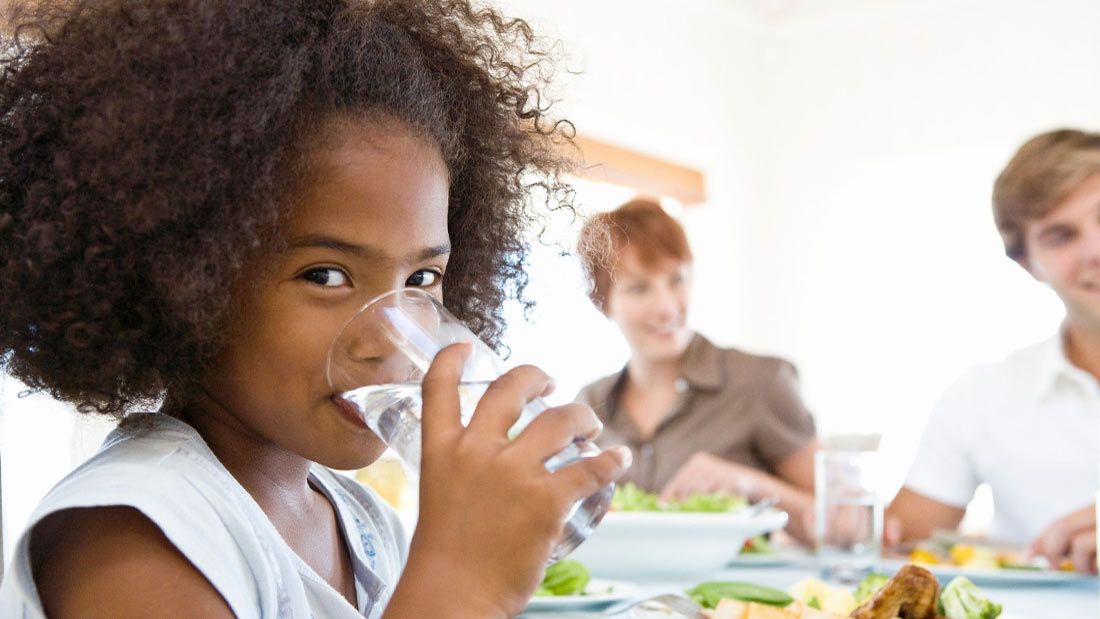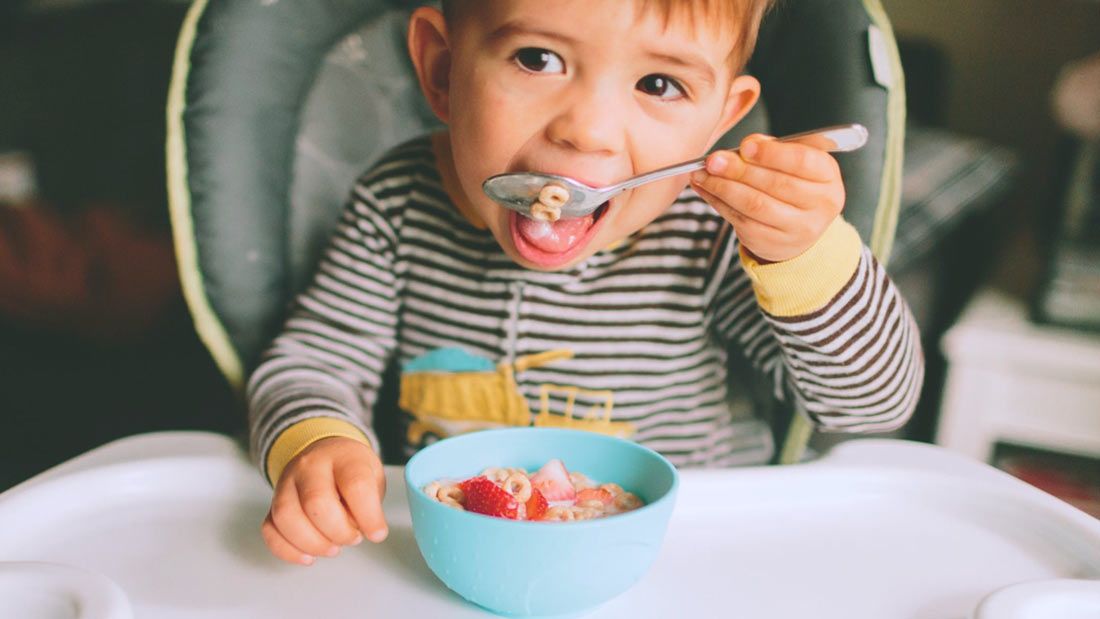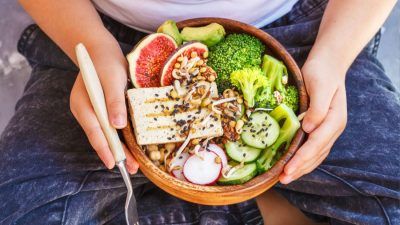Feeding a growing body

You probably know that babies’ first foods should be mushy, that they shouldn’t be given food in pieces that might pose a choking hazard or that they need snacks. But what else is there to know about feeding children? What should every parent know about their child’s changing dietary needs?
Each child has specific requirements and preferences but they also have many things in common. Most importantly, children are not small adults so they need a different approach to food. Here are the key points, starting with guidelines for babies and ending with suggestions for older kids.
A well-planned vegan diet is perfect for people of all ages, including babies and small children. This is what do you need to know about each stage of your child’s life:
Before six months
Your baby needs only breastmilk or formula milk if breastfeeding isn’t possible. Breastfed babies should get vitamin D drops via your breastmilk to ensure they get enough of this important vitamin – recommended dose is 10 micrograms (or 400 IU) a day. If you’re breastfeeding, also make sure you take a daily vitamin B12 supplement (at least 50 micrograms) so enough of it passes into your breastmilk. (Bear in mind you should take B12 even if you’re not breastfeeding.)
If you cannot give breastmilk to your baby, there are non-dairy infant formulas available and suitable to give to babies from birth. These formulas are required by law to contain vitamins D and B12, so you don’t need to give your baby any extra. (Unfortunately, in the UK none are vegan as the vitamin D used is sourced from lanolin in sheep wool. A widely available non-dairy formula is SMA Wysoy. However, as soya infant formulas are not made from cow’s milk, they contain much fewer animal products than dairy formulas.)
As a general rule, babies shouldn’t be given any solid foods before four months and many people argue that you should wait until six months but babies are curious so introducing first foods after four months is fine so long as you choose the food carefully (see below). However, the absolute majority of their energy needs is to be provided by breastmilk or formula.
Six to 12 months
From six months, you can start giving your baby small amounts of puréed or mashed foods on a spoon. These should include good iron sources, such as mashed beans (ideally peeled), lentils, chickpeas and tofu, all without added sugar or salt. They are best combined with other foods, such as nut or seed butters, avocado, sweet potatoes, bananas and other soft fruit and vegetables. You can also try soft bread cut into strips, pasta, age-suitable cereal products (low sugar and salt), porridge and a little soya yoghurt.
Aside from breastmilk or formula, try giving your baby small amounts of water and home-made fruit smoothies or purees for an added vitamin dose.
Continue with vitamin D drops and depending on what your baby eats, you may need to consider their vitamin A and vitamin C intakes, also. It’s best to talk to your healthcare provider to decide if your baby needs multivitamin drops.
When your baby starts teething, it’s time to introduce ‘finger foods’ that can be chewed and explored – fruit, vegetables or bread cut into a size and shape that your baby can easily hold in his or her fist. Make sure you watch your baby eating as there’s always the risk of choking. If you give them smaller pieces of food, such as grapes, stay with them while they’re eating and always mash small but chunky foods like peas and beans to avoid your baby accidentally inhaling them.
Toddlers
As your child starts eating more solid foods and has less breastmilk or formula, it’s important to make sure they eat enough. Their tummies are small but they burn a lot of energy so it’s best to feed them small amounts of food often. A toddler should eat every two hours.
Be careful with salt, sugar, spices and condiments – ideally, they shouldn’t have any at this age. But that doesn’t mean you can’t have the same meals as a family! Take out a small portion of a meal you’re cooking before you add the final seasoning. That way you’ll have a baby and adult version of your meals and it’s encouraging for your toddler to see you eating the same foods as them.
Although wholegrains are recommended as a healthy option for everyone, it’s best to choose white or half-white versions of bread, pasta or rice for very small children. They contain less fibre and your child won’t fill up too fast.
And just like with babies, avoid giving children under five whole nuts and make sure you always watch them eating – there’s a risk of choking whatever the diet.
Alongside breastfeeding or formula, you can also start giving your toddler special soya milk, fortified specifically for children over 12 months – eg Alpro Growing Up Drink. If your baby is allergic to soya, try fortified oat milk but only as an extra drink, it shouldn’t be their main energy source.
Vegan toddlers also need a reliable source of vitamins B12 and D – see the Supplements section for details.
Three to six year-olds
Your child needs a lot of energy and nutrients so feed them three main meals and two or three snacks. At this stage, building a meal routine is important to ensure they eat enough. Include five portions of fruit and vegetables, starchy foods such as wholemeal bread, pasta, brown rice, root vegetables, sweet potatoes and potatoes, pulses, nuts and seeds (the latter two as nut or seed butters avoid choking hazard), calcium fortified yoghurts and drinks. It’s best to steer clear of low-fat versions of foods because children need all the energy they can get!
See How to make healthy vegan meals and snacks for kids for guidance on how to put together nutritious meals, tips for snacks and how to increase the nutrition value of your kid’s meal if they are a picky eater. And it’s also worth looking at How to get children to eat healthily? for practical information.
Children over six and teenagers
The main food groups remain the same – fruit and vegetables, wholegrains, nuts and seeds, pulses – but carry on increasing your child’s portions steadily.
With peer pressure at school and your child’s growing independence, unhealthy snacks can start creeping in and your child might want to live on sweets and processed treats. It may be difficult to make them eat the food they need but it’s important to establish a good balance. Blend fruit and vegetables in fresh smoothies, add nut butters or tahini to main meals, blend veggies in soups and sauces, make dips from beans and peas, make them healthy but tasty sandwiches but, most importantly, lead by example and eat the same foods as them!
At this age, it’s also great to include your child in choosing foods in shops and preparing their meals with you – a degree of choice will encourage them to eat more foods and it might make them curious about new foods, too. And if that doesn’t work, keep trying – it may take 20 times before your child agrees to taste a new food but over that period their curiosity and willingness to try builds up so be patient – it does work!
Check out How to make healthy vegan meals and snacks for kids for specific information on foods and supplements.
Note on drinks
Encourage your child to drink water from an early age. A sweet or fizzy drink habit is hard to break so the best option at mealtimes is always water. Home-made smoothies are great as nutritious snacks but the main source of fluids should still be plain water.

Children usually can’t eat much in one sitting (there are exceptions of course) simply because their stomachs are small. However, they burn energy fast so they need smaller portions and more often.
Even though children may not necessarily be sticking to the routine of breakfast, lunch and dinner at the usual times, it’s good to aim for three bigger meals and several snacks in between. Just bear in mind that the snacks shouldn’t be so big that they would then be still full at mealtime.
Younger children should eat every two hours, while older kids every three hours. In general, a child shouldn’t go as long as six hours without a good protein and energy source (Baroni et al., 2018).
Make sure you give them healthy, nutritious snacks between meals and for children of school age, always pack a snack-box to take to school. For ideas see How to make healthy vegan meals and snacks for kids.
Children have higher protein needs and although these can be met with beans, chickpeas, lentils or soya, it may be practical to also include some protein-rich mock meat products (made with soya, wheat or pea protein) because we absorb more protein from them. Studies say that while we absorb about 80-90 per cent of protein from cereals and pulses, we absorb around 95 per cent from mock-meats (Agnoli, 2017). That’s not to say you should be relying on vegan hot dogs and burgers daily – but it’s good to mix it up a little, especially if your child isn’t a big eater.
Nuts and seeds also provide protein which makes them ideal snacks, breakfast toppings and smoothie ingredients, or you can use nut butters for sandwiches or as a thickener in sauces.
Wholegrains (wholemeal bread, brown rice, whole wheat pasta) are amazing sources of energy, fibre, protein, vitamins and minerals. Everyone is encouraged to eat them but not babies up to 12 months of age. It’s because fibre can fill them up and reduce the amount of food they eat or milk they drink, decreasing their energy intake (Baroni et al., 2018). In their complementary feeds (additional to breast- or formula milk), they can get fruit and vegetable purées, mashed lentils or beans, but other plant foods are recommended to have lower fibre content, such as tofu, plant yoghurts, white bread, children’s cereal products or mashed potatoes.
As babies become toddlers, they can eat wholegrains too but because their growth is still very fast, it’s best to mix wholegrains and refined grain products. The older children get, the more wholegrains and other wholesome plant foods they should be eating.

Children have high energy needs so their fat intake shouldn’t be limited, certainly not in infancy and early childhood – but they should be eating the right kinds of fat (Baroni et al., 2018).
Coconut and palm oil are very high in saturated fats that are not healthy, so children shouldn’t eat much of them. Trans or hydrogenated fats should be completely avoided as they don’t provide any vital nutrients and can contribute to a number of health issues.
It’s best to focus on good sources of healthy fats – unsaturated omega-3s from chia seeds, flaxseed oil and walnuts, rapeseed oil for cooking, virgin olive oil for drizzling on cooked meals, avocados, nuts and seeds in general, nut butters and tahini (sesame seed paste).
For more on fats and child health, see the Nutrients section.
Children like routine and familiar things but sometimes, they may get too attached to always having the same thing – eg one piece of toast or a certain sized portion. As they’re growing up, they need more of everything but you may be met with resistance to changing their usual portion sizes.
To get around that issue, don’t increase the serving but add a few things to go with it. Do it repeatedly and eventually, increase the serving size too. Explain to them that they will need the extra energy – if they don’t want to eat it, try to reach a compromise that they will eat at least some of the extra food. If you do this many times, one day they won’t question the extra portion and accept it as the new normal. Another trick is to change the plate or bowl to a bigger one, so the bigger portion still looks small relative to the dish size.
On the other hand, if your child suddenly starts eating a lot more, don’t restrict them unless they’re carrying too much extra weight. Let them fill up but steer their selection of foods so they are not filling up with crisps and chocolate.
For guidance on healthy meals and snacks, see How to make healthy vegan meals and snacks for kids.







